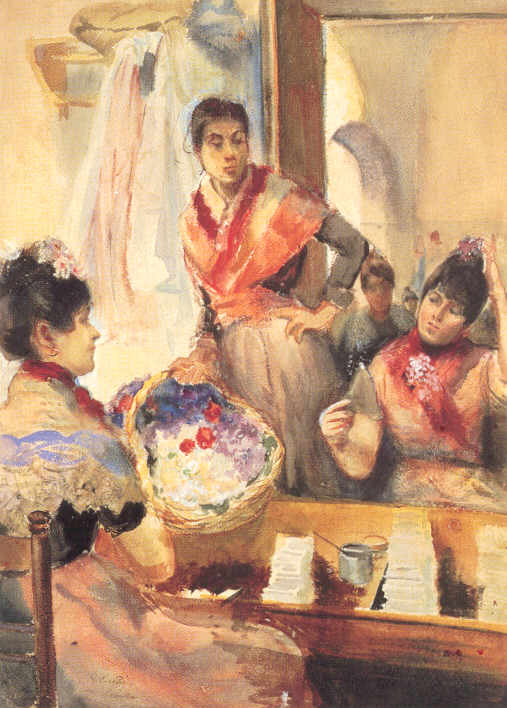|
Cigarreras in Seville
Ralph Wormeley Curtis
(1854-1922)
American painter
c. 1888
Private collection
Watercolor on paper
919 7/8
x 13 7/8 in.)
Jpg: local source
When Ralph Curtis sat down with his
good friend John Singer Sargent in May of 1884, after the latter’s public
rejection of his now very famous Salon painting Madame X, it was
Ralph’s intent to get John thinking about happier times. In the last of
Ralph’s letter
to his parents about that most unhappy event, he said: “I want him
to go to Seville and do the tobacco girls with me in Nov.”
Curtis’ peculiar reference to Seville
and the tobacco girls alluded me for some time, but now I know --
and this painting is part of it. What he was doing was an obvious attempt
by a good friend to turn Sargent’s attention away from his public rejection
and towards his most popular and powerful painting El Jaleo (which
Sargent painted in 1882 and showed at the Salon that year). The French
loved that painting. In the eyes of many, El Jaleo
beckoned the passionate opera “Carmen”. The heroine of the opera was a
tobacco girl (or a girl who rolled cigarettes in a factory -- which was
how they were made - by hand). Ralph wanted to get Sargent thinking about
his successes and not his failures.
Sargent did agree to go, but plans
were canceled because of a reported cholera outbreak in Spain later that
year (‘84).
Curtis eventually went himself (approximately
'88) but Sargent wasn’t with him. In Seville he paints Carmen Arrested
at the Tobacco Factory in Seville (1888 location unknown) and exhibited
it at the Paris Salon in May ‘88. He also painted a flamenco dance picture
and in reference to it, he writes to Isabella Stewart Gardner, the owner
of El Jaleo and close mutual friend of Sargent's:
It is much more terre a
terre than John Sargent’s “page macabre”. I have the audience too, who
is to me half the fun. It is realistic to the last paint! And delights
the profane sitters.
(footnote
1)
The theme of "Carmen"
was most powerful in the imagination of the French and when the writer
Howe Downes visited Seville he described the tobacco factory this way:
The girls were very decidedly
décolletées, and some of them came startlingly near to wearing
nothing at all, but they usually threw a light shawl over their shoulders
when they saw a party of male visitors approaching. One room alone contained
no less than 3,300 women. As we entered the sounds of their voices was
like a distant roar of the breakers on the ocean strand. The cigarreras,
many of whom are great beauties, form a class by themselves, and unhappily
are not noted for their chastity. Of course we thought of the “Carmen”
of the opera, and on coming out of the factory were pleased to discover
that an infantry barracks occupied the opposite side of the square, thus
verifying the scene of Bizet’s work.
(footnote
2)
Curtis' watercolor: Cigarreras in
Seville, this painting, speaks of that same subject but less allegorically
than his Carmen Arrested (which I would love to see an image of).
This painting could have possibly been part of a group of paintings he
did with the anticipation of that Salon exhibition.
by: Natasha
Wallace
Copyright 2000 all rights reserved
Footnotes
-
See more on Ralph
Wormeley Curtis
-
1) Letter from Ralph Curtis to Isabella
Stewart Gardner, Seville, 25 March [1888], Isabella Stewart Gardner Papers,
Archives of American Art, Smithsonian Institution, Reel 396; quoted in
Espana: American Artists and the Spanish Experience, M. Elizabeth Boone,
Hollis Taggart Galleries, New York, 1988, p. 60, 1998
-
2) William Howe Downes, Spanish Ways
and By-ways, with Glimpse of the Pyrenees (Boston Cupples, Upham, &
Company, 1883), pp. 87-88; quoted in Espana: American Artists and the
Spanish Experience, M. Elizabeth Boone, (Hollis Taggart Galleries,
New York, 1998), p. 60
-
Natasha's cliff notes on Carmen
-
See
more discussion on the Opera Carmen-- more in depth
-
Isabella
Stewart Gardner
|


